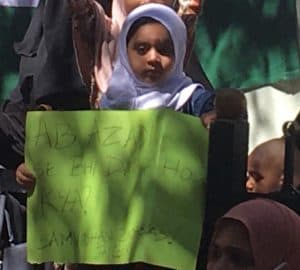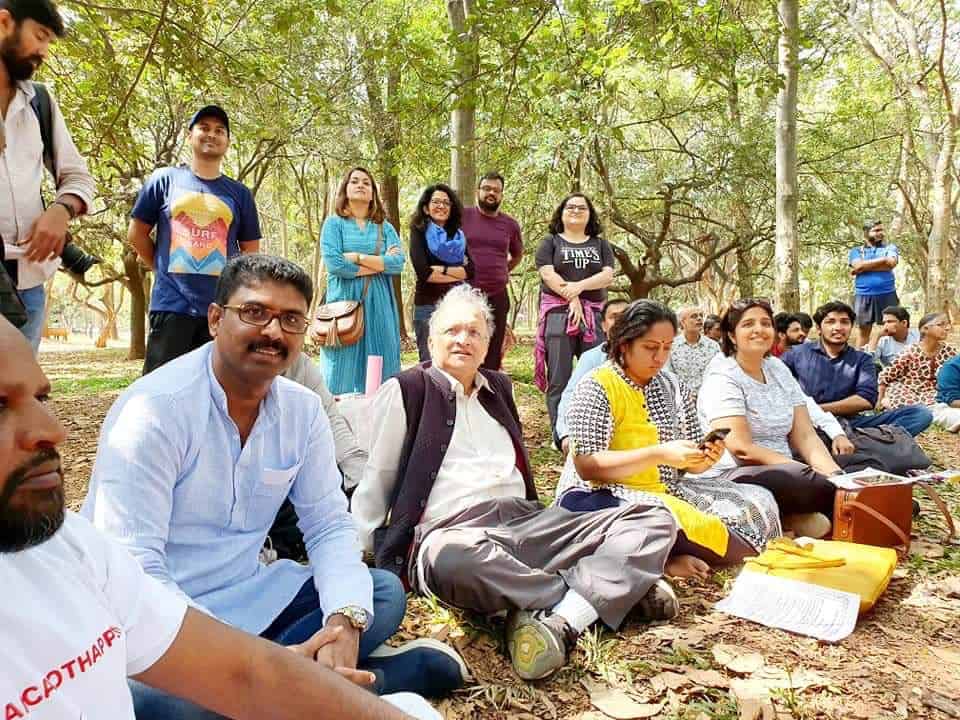Starting today, freedom fighter H S Doreswamy, aged 101 years, is to lead a satyagraha at the Town Hall from 11 am to 5 pm, for five days. The protest is against the central government’s position on the CAA (Citizenship Amendment Act), along with other issues such as economic slowdown and price rise.
Kavitha Reddy, one of the organisers, says Doreswamy had submitted the application to the police seeking permission for the protest, weeks ago. “We got a call from the local police station yesterday, and they collected all details of the protest.”
She says that the police didn’t mention anything about permission at the time. “But at 11.30 at night, they went to Doreswamy’s house and told him that he’d been denied permission,” says Kavita.
However, Doreswamy refused to budge, and is at the protest venue today. This incident reflects two things – the tenacity of Bengaluru protesters and the administration’s efforts to discourage protests.
When a similar anti-CAA satyagraha was organised in Frazer Town on January 23, several thousands had attended. The satyagraha was to end the next day, the 24th. But on 24th afternoon, I got four different Watsapp messages – one from a students’ group, another from a women’s group, a third from an organiser, and the fourth from an individual protester – all informing me that the satyagraha was being extended by another 24 hours.
If that’s any indication of how this movement is building up, it’s clear that varied strands of civil society are coming together in Bengaluru. Be it at Town Hall, Freedom Park or rallies, there are familiar faces, dedicated volunteers who manage everything from discipline, traffic and water provision, to standing for hours holding placards.
A news report in Times of India last month said that the city saw 82 protests in just 30 days. And as Doreswamy’s satyagraha today indicates, the movement is only growing.
What has brought people from different backgrounds to these protests? And how have the protests sustained over months in Bengaluru, without losing momentum?
Diverse groups come together
The Frazer Town satyagraha had been organised by ‘Hum Bharat Ke Log’ – a national collective formed to protest CAA – but was supported by another protester group ‘We The People’, and students from various colleges. Adjacent to Ismail Sait Mosque, a large group of Muslim women around Frazen Town started the protest on 23rd afternoon, in solidarity with their sisters in Shaheen Bagh, Delhi.
They were soon joined by students, women artists, activists and others. These citizens live far from each other, have different vocations or are students or retirees, and their age ranges from 20s to 60s. Participation varied through the satyagraha, but at its peak 8000-10,000 people were present, I was told.
On the 24th, protesters were gathered under a shamiana on a rather warm day for Bengaluru. An elderly protester, dressed in burqa and playing with her grandchild, spoke in English, “My daughter, her one-year-old and I have been here since yesterday afternoon. We went home only to finish household chores and freshen up. We can’t let the space empty out.”

Muslim women had started off the January 23rd satyagraha in Frazer Town. Pic: Prachi Pinglay-Plumber
Nimmi, an artist, says, “We have flexible hours. We come here whenever we can for as long as we can. Also, we do not want the onus of saving democracy to be thrust only on our Muslim brothers and sisters.”
While several protesters held placards, some others were busy making these, and a few were sticking posters on the opposite side of the road. Over the two-day satyagraha, activists who had visited Uttar Pradesh and Jamia Milia spoke about their experiences. Musicians sang revolutionary protest songs, including the beautiful Kannada version of Hum Dekhenge – Navu Nodona by Pallavi Bindhumalini.
From creativity to cooperation with the police, everything at Frazer Town reflected how all protests have been organised in the city.
What particularly differentiates the anti-CAA protests though is the way groups that usually have varying agendas – workers, students, feminists etc – have come together. For example, during the All India Bandh on January 8, workers in Bengaluru lent their support to the anti-CAA protests. Students and civil society organisations had supported the workers’ strike as well.
On January 5, women in the city organised a ‘Burqa and Bindi Protest’ around feminist icon Savitri Bai Phule’s birthday. The protest highlighted how women particularly, would be affected by the CAA and NRC (National Register of Citizens).
These protests also become meeting grounds for people from different groups, leading to new alliances.
Clifton D’Rozario of the Alternative Law Forum (ALF), one of the organisers of the protests, says there’s been no need for special mobilisation efforts. “On one hand people are coming together, and on the other, the government is trying to delegitimise the resistance which is why there have been brazen attacks of Jamia, AMU and JNU. People are really angry and mobilised by this alone.”

At Frazen Town satyagraha. Pic: Prachi Pinglay-Plumber
Citizens usually come to know of upcoming protests through social media. Many also keep in touch with those they meet at protests, and coordinate further. There are also people who come by themselves to show solidarity. Mehroz Khan, lead organiser with the collective We the People, says not much funds are needed for the protests, and that they manage it among themselves.
People have “no choice but to fight back,” says D’Rozario, “It’s not just about one law. It’s an assault on the fabric of our country and on our Constitution.”
Dialogue, not conflict
Protesters in Bengaluru have tried to reach out to the public including those who support the CAA. Last month, they also decided to go on door-to-door campaigns.
Geeta Menon, a domestic workers’ rights activist in the city, has been part of this. She says, “It’s by ideas that people are converted. Discussions and engagement at the community level, though tedious, is the only way forward. A lot of Muslims come to the protests, but we are trying to tell people that it’s also about Dalits, Adivasis and Hindu minorities.”
Geeta says they conducted a Padayatra to inform citizens of these implications, but that reaching out to people one-on-one has been difficult. Now they reach out by standing at street corners and taking signature campaigns.
“When people see us standing with placards, they come to see what it’s about. Once an auto driver stopped to say he supported the CAA. But when we pointed out that he himself had different names in different ID cards, he understood the problem,” says Geeta. “We cannot have blanket assumptions that people are for CAA; you never know, they may listen.”

A workshop for children to read and understand the preamble to the Constitution, organised recently by women professionals in the city. Pic: Mehroz Khan
Mehroz Khan says of ‘We The People’ collective: “We are visiting places like Bagalkot, Belgaum and Udupi to form local groups. We are planning to go to villages.” He says CAA has wider implications – it would affect not just the social fabric of the country, but also its economy.
Khan maintains that Bengaluru Police has been supportive of the protests overall and there haven’t been too many confrontations. Some may say otherwise, given that the police had objected to placards about Kashmir or had asked people to disperse after 9 pm from venues like Freedom Park. But yes, there’s been no violence.
| “Bengaluru not new to such protests”
Senior journalist Ammu Joseph says it’s not unprecedented for Bengaluru to come out on the streets. “There were a lot of demonstrations after the demolition of Babri Masjid. We – a mixed group of people including Muslims – had formed a coalition for secularism, and used to meet every week. We had organised the ‘Sehmat Exhibition’ on Ayodhya. We had protested even after the attack on artist M F Husain. But yes, they were not as consistent as these protests.” She believes that a combination of factors has led to the current public response. “There have been lynchings and other violence in the past, but the law has made people feel that if they don’t resist now, it’s going to be too late. Muslim women are very determined, and the elite are joining too. The student leadership is special as they were not so engaged with the larger public good earlier.” |
Students most adept at gathering crowds
At the forefront of the protests – like everywhere else in the country – are students, who are turning up in large numbers, connecting and coordinating, and also creating fabulous protest art.
At the Frazer Town satyagraha, student volunteers distribute bananas, water and give out instructions. The elders are protective and appreciative of their efforts.
The students who spoke to me said they can’t reveal the identity of their colleges as they are not representing their colleges at the protests. Sumaiya, a student, says most colleges don’t entertain protests inside the campus.
She says, “The focus is more on students because we can gather huge crowds by linking a single representative from each college, who can then pass on the information to other students and gather them. We usually go in large numbers. We can work for a successful protest, systematic and organised.” Sumaiya is new to protests but has been balancing her studies with volunteering, while assuring her parents of her safety.
Saqib, another student and part of Hum Bharat Ke Log, says he’s been involved for about a month. “We have campaigns, and have reached out to students from 30 colleges for the alliance.” In addition to the reported number of 82 protests, there have been several smaller ones – candle light vigils, rap protests, indoor programmes in madrassas or slums, and streets even. “I have been part of many such – they go unnoticed,” says Saqib.

Sahasra Saha Bhojana to celebrate birth anniversary of Kuvempu and the Indian Constitution, in December at Cubbon Park. Historian Ramachandra Guha was present. Pic: Mehroz Khan
In addition to rallies and sit-in protests, collectives like Hum Bharat Ke Log and We the People have organised public interactions and speeches like those by Kannan Gopinathan and Sasikanth Senthil. The attendance at these events have ranged from a few thousand to over a lakh.
At an earlier interaction in Bengaluru, Kannan Gopinathan – the IAS officer who quit services over abrogation of article 370 in Kashmir – summed up why these protests were special: “Earlier the intellectuals were protesting, or the JNU students were protesting or a community was protesting. Intellectuals were not coming out with the masses. Now you are seeing students, intellectuals coming out with the masses. Ramchandra Guha is getting arrested along with the protestors, so that is a powerful symbol – a leading historian is coming and asserting his fundamental right like a student or a labourer does.”
Come whatever, CAA will be implemented in its current form. Jai Modi Jai Amith Shah.